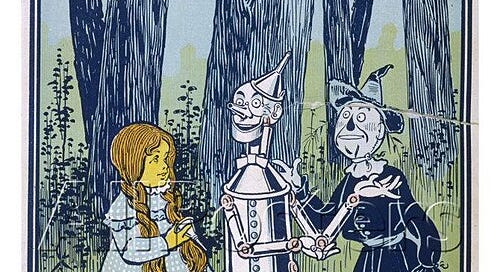Tiny Wonders: The Joy at the End of the Yellow Brick Road
on literary friendships, conference magic, and the courage to welcome others
Part of the Tiny Wonders series: short reflections on children’s books, faith, and everyday holiness
Dear fellow wonderers,
I’ve just returned from Boston, where I presented at the American Literature Association conference—a nearly annual pattern in my academic life that has begun to feel like a kind of literary homecoming.
I still remember the first time I went. I was a graduate student, shy and unsure of myself, clutching my paper like a lifeline, my hands shaking as I stepped up to present. I didn’t know anyone. I barely knew how the whole thing worked. At literature conferences, for those of you who’ve never been, we gather in different rooms throughout the hotel to share and discuss our latest research—each panel a mix of ideas and voices that form a living conversation across texts, time periods, and disciplines. Back then, I remember thinking: Who am I to be here? What right do I have to join this conversation?
The receptions felt intimidating. The panels, overwhelming. But a few people—just a few, now beloved gems of friends in my life—noticed me. They smiled. They asked a question. They opened up space. That was enough. It didn’t take a crowd. It took kindness. And it sounds cheesy, yes, but I’ll say it: it made all the difference.
So now, more than a decade later, when I walk into those same hotel lobbies and conference rooms, I do so with a sense of recognition and joy. I reconnect with friends, meet new ones, and remember what it feels like to belong—not because everything is easy, but because you’re walking the road with people who care. And I try to offer that same welcome to others whenever the opportunity presents itself.
That’s the kind of joy I see in Dorothy Gale, the subject of my presentation this year—and of this very Substack post—because I wanted to spread the joy of this conference to all of you, my dear readers!
She’s also a central figure in a new book I’m co-writing with Dr. Gregory Eiselein of Kansas State University, Stoic Joy and Its American Literary Heroines. And the more I sit with her story, the more I realize how rare she is, not just in Oz, but in literature and in life, for that matter.
We could all stand to be a little more like Dorothy.
Because when you know someone like her, you know. I’m thinking of a conference friend with the warmest smile and big, bold, sparkly glasses. Another who asks the gentlest, most thoughtful questions that lead you to grand epiphanies. Another who throws the best, grandest parties and makes you laugh with her witticisms. Each of them (and others!) has reached out to me in small ways over the years, reminding me of Dorothy, and making me want to live a little more like their best qualities: a little better, a little braver, a little more joyful.
Now, Dorothy isn’t wildly imaginative like Anne Shirley or daringly plucky like Pippi Longstocking. She doesn’t outwit villains with clever tricks or dazzle anyone with charisma beyond her years. She’s a good, kind friend. She’s thoughtful. She’s loyal. She pays attention. She asks questions. She acts with care and conviction, even when she’s afraid. You want Dorothy as a friend because you know she’ll reach out to you. You know she’ll stick up for you.
Because here’s the thing:
Dorothy is the change-maker.
She doesn’t wait to be welcomed: she welcomes.
She doesn’t seek out power: she offers presence.
She’s the one who frees the Scarecrow, oils the Tin Woodman, befriends the Cowardly Lion. Her journey becomes joyful not because of where she’s headed, but because of what she builds along the way: trust, companionship, mutual courage that forges community.
There’s a moment near the end of the book, just before the last leg of the unlikely friends’ journey, that captures this spirit almost perfectly:
“The sun shone brightly as our friends turned their faces toward the Land of the South. They were all in the best of spirits, and laughed and chatted together. Dorothy was once more filled with the hope of getting home, and the Scarecrow and the Tin Woodman were glad to be of use to her. As for the Lion, he sniffed the fresh air with delight and whisked his tail from side to side in pure joy at being in the country again, while Toto ran around them and chased the moths and butterflies, barking merrily all the time.”
There’s no villain here to defeat. No wizard to impress. Just four friends, walking. And yet the scene radiates joy—not the joy of arrival, but the joy of being together. Dorothy’s hope, the Lion’s delight, Toto’s barking: it’s a picture of what friendship looks like when it’s lived with intention and care.
For those of us who grew up with books as our companions (ok, yes—our friends), for those of us who once read The Wonderful Wizard of Oz under a blanket or in a quiet corner of the school library, there’s something nearly luminous about returning to these stories as adults. We see the yellow brick road differently now. We know how long and strange the road can be. But we also know what it means to walk it together—and to recognize that walking, that path of companionship and togetherness and the twists and turns along the way to get there, as joy. As Dorothy’s story reminds us:
“There’s no place like home.”
And often that home isn’t only at the end of the road, but it’s along the way, too, in the friendships and community we build as we adventure together in our lives.
What story has helped you feel at home—in a place, in a community, or even in your own skin?
In hope and holy curiosity,
LuElla




